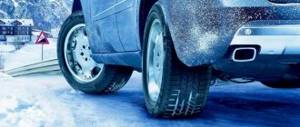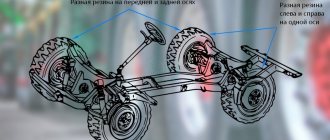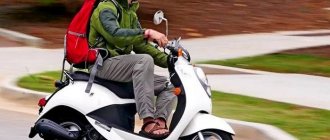Every year, as cold weather approaches, drivers begin to wonder when to put on winter tires. Currently, the answer to this question is partially regulated by a regulatory legal document.
The relevant law is Technical Regulations of the Customs Union TR CU 018/2011 On the safety of wheeled vehicles.
In this article we will talk about the legally established deadlines for changing summer tires to winter ones. In addition, a fine for improper use of tires will be considered.
Restrictions for driving out of season
Until 2015, the Law did not provide for fines for driving on winter tires in the summer, although there were attempts to introduce it back in 2013. In 2014, the Technical Regulations of the Customs Union were adopted, according to which, from the beginning of 2015, a fine was introduced for driving a car on out-of-season tires .
The regulations include provisions according to which it is prohibited to drive on summer tires in the winter months - December, January, February, and on winter tires in the summer - June, July and August, respectively. That is, driving on any tires in the fall or spring is not considered a violation.
The regulation also states that the rules for the use of seasonal tires can be adjusted according to the weather conditions of each region.
It is clear that somewhere in the northern regions of the country no one drives summer tires due to permafrost, however, amendments to the regulations must be adopted by each region separately, so in the first time after its adoption, misunderstandings may arise with traffic police officers.
Is it possible to ride on Velcro in the summer: traffic rules data
According to most car enthusiasts, Velcro can be used in the summer. Indeed, until recently there were no legislative prohibitions on this.
The legislation was changed in 2021. Mention of winter studded tires was removed from the technical regulations and the concept of “winter tires” as a whole was retained. As a result, there was a ban on the use of Velcro from the beginning of June to the end of August. The police will no longer get away with such violations. The violator will first be given a warning and then a fine.
When is it legal to switch to winter tires?
Let's consider paragraph 5.5 of Appendix 8 to the technical regulations of the customs union TR CU 018/2011 “On the safety of wheeled vehicles”:
5.5. It is prohibited to operate vehicles equipped with tires with anti-skid studs in the summer (June, July, August).
During the winter period (December, January, February), the operation of vehicles of categories M1 and N1 that are not equipped with winter tires that meet the requirements of paragraph 5.6.3 of this annex is prohibited. Winter tires are installed on all wheels of these vehicles.
A period different from that specified in paragraph one of this paragraph may be established by the legislation of a member state of the Eurasian Economic Union in connection with climatic and geographical factors characteristic of member states of the Eurasian Economic Union.
So, what can be understood from this paragraph:
- During the summer months (June, July, August) only studded tires are prohibited. This requirement applies to all vehicles.
- During the winter months (December, January, February), only winter tires are permitted. You can put both studded and non-studded tires on your car. The main thing is that they are marked “M+S”, “M&S” or “MS” and the corresponding drawing (in the picture on the left). The requirement applies only to category B (M1 cars and N1 trucks). The restriction does not apply to other vehicles from November 11, 2021.
- The terms of the ban on exploitation can only be increased by the legislative authority of any level (federal, regional) and cannot be reduced. Those. In your region, for example, the use of studded tires may be prohibited from May to September. At the same time, regional authorities cannot reduce the period of the ban, i.e. From June to August, cars in all regions must not use studs.
Thus, there are the following intervals for using car tires:
- Summer tires (without M+S marking, etc.) can be used from March to November.
- Winter studded tires (marked M+S, etc.) can be used from September to May.
- Winter studless tires (marked M+S, etc.) can be used all year round.
Let's look at a table with periods of possible tire use throughout the year:
| Summer | Winter studded | Winter studless | |
| Winter (December - February) | + | + | |
| Spring (March - May) | + | + | + |
| Summer (June - August) | + | + | |
| Autumn (September - November) | + | + | + |
Thus, if you have summer tires (without markings) and winter studded tires, then you must replace them during the fall, i.e. from September to November.
We recommend: Step-by-step instructions for removing bumpers from a VAZ 2113-2115
The tire replacement should be done during the spring, i.e. from March to May.
From a legal point of view
Driving on winter tires will not end with car problems alone. There are ongoing moves to introduce specific regulations and penalties for the use of winter tires in the summer. In 2014, the Technical Regulations of the Customs Union were signed, according to which, from 2015, a driver using a car with winter tires in the summer will be fined.
TR CU 018/2011 “On the safety of wheeled vehicles”, in addition to restrictions on the operation of bald tires, introduces prohibitions regarding the rules for operating tires on the roads:
- The ban applies only to vehicles equipped with tires with anti-skid studs.
- A fine will be issued if studded tires are used between June and August, i.e. Only during the calendar summer months this cannot be done. At the same time, there is no precise legislative indication of which tires to drive in autumn and spring and when a set change is required. However, there is a provision that the rules for using seasonal tires can be determined taking into account the climatic and weather conditions of a particular region. For example, in areas of northern latitudes, summer tires are not required at all.
- Tread depth requirements prohibiting the use of bald tires. For the summer set, tires with a depth of less than 1.6 mm cannot be used. For a winter set, the tread depth should be from 4 mm.
- Repeated fines will not increase the amount imposed.
The technical regulations of the Customs Union contain norms of international law that are equivalent to domestic legislation. It does not contain provisions regarding the rules and service life of other types of winter tires. Therefore, this ban will not yet affect owners of cars equipped with tires with Velcro.
The amount of the fine is established in accordance with Part 1 of Article 12.5 of the Code of Administrative Offenses of the Russian Federation - 500 rubles.
Why you can't drive on winter tires in summer
It is well known that summer tires make the car less controllable in winter due to the small tread depth and tire hardness.
What are the dangers of using winter tires in summer? The alloy of winter tires is softer in structure than summer tires and this has the following consequences:
- Increased braking distance due to increased rubber melting.
- Poor handling due to poor adhesion to asphalt.
- Tires become very hot.
- Rapid wear - the tread of winter tires will wear off in a few trips, and the tire will simply become unusable.
The role of spines
Studded tires promote unhindered maneuverability on snowy roads, good traction on icy surfaces, normal acceleration, braking and vehicle handling in bad weather conditions.
If the studs fall out of the tires, the risk of an accident increases, since the rubber becomes practically unusable:
- The braking distance increases.
- The tire does not grip the ice and does not puncture it, but only slides.
- If there is a “porridge” of snow on the road during the thaw, driving becomes more difficult.
Is it worth driving with winter tires in summer?
Using winter tires for purposes other than their intended purpose leads to a number of detrimental consequences for the car and the driver: a high risk of accidents on the roads, difficulties with driving, rapid wear and failure of a number of vehicle systems, increased fuel consumption and, finally, a fine.
The question of why it is necessary to change winter tires to a summer set has a clear answer - such trips on asphalt in the hot season will not bring anything good. However, much depends on where the car is used and in what climatic conditions. On roads in northern latitudes, in the permafrost zone, it is worth adhering to common sense and the rules established for a specific region.
The question of when to change tires to summer ones is resolved in a similar way. There is a widespread opinion about the timing of replacing a seasonal tire: March 15 – switch to summer tires, November 15 – switch to winter tires. However, there is no precisely established single date in the law, and tires must be changed, taking into account the climate of a particular region and specific weather conditions.
Buying two sets of tires every year is quite expensive, especially in times of crisis. It is not surprising that more and more drivers decide to save money and drive in the summer on worn-out winter tires. Why people prefer “winter” to summer is not so difficult to guess - it’s all because of savings. Removing the purchase of a set of summer tires from your expenses means saving almost half of the average Russian’s monthly salary. However, there are many pitfalls in using winter tires in summer, which we will talk about today.
1. Steering response becomes less clear
Winter tires are made of softer types of rubber, and the tread is replete with a large number of small grooves. This allows the car to hold the road well on snow or frozen asphalt. When driving on a sun-heated road surface, winter tires act as a shock absorber, thereby creating a cushion effect between the car and the road. The car becomes “rolly”, and the car’s response to steering becomes blurred and slow. On average, the efficiency of driving in summer on winter tires is almost 10 times less than when using summer tires.
2. Braking distance.
As the asphalt temperature rises, winter tires begin to wear out very quickly, not providing proper grip. When braking, this results in an increased braking distance, and, consequently, can lead to an emergency situation on the road. Various companies have conducted tests, during which they were able to prove that the braking distance in summer at a speed of 50 km/h is 1.5 meters longer, and at a speed of 100 km/h it is already 6 meters longer than on summer tires.
3. Noise in the cabin
It's not difficult to notice that winter tires have a lot of edges, unlike the streamlined summer models. Each additional edge of the tire in contact with the road creates additional noise. The more such edges, the noisier the car on the road. Studded tires make even more noise.
4. Fuel consumption
The less grip there is, the more difficult it is for the car to move on the road. Due to their soft texture and heavily “rugged” tread, winter tires make it difficult for the car to grip the road. The engine revs harder to reach the same speed, which means more fuel is consumed.
5. Wear
At temperatures above 7 degrees, the rubber wears out greatly. If you plan to use tires for the next winter season, then there is a high probability that the wear will be maximum and the only thing left to do is throw the tires away.
6. Cornering
Winter tires do not cope well with strong lateral acceleration, so when cornering it is better to choose a lower speed, otherwise there is a high risk of severe car drift and an accident.
Many car enthusiasts will answer this question in the affirmative, citing the fact that nothing particularly terrible will happen, because the car will not stick to the asphalt, in fact. Unfortunately, this opinion is deeply mistaken and, worst of all, such recklessness can even be dangerous, both for the driver himself and for pedestrians. Drivers who use winter tires in summer are acting recklessly, given that:
- 1. This is dangerous - if an unforeseen situation arises in the summer heat, winter tires are highly likely to let you down.
- 2. It’s expensive - using winter tires in the summer will cost you significantly more than any possible fines.
- 3. This is unpleasant - even an ultra-modern foreign car in hot conditions with winter tires will be difficult to control.
We recommend: Effective measures to eliminate problems of poor operation of the stove on a VAZ-2114
And the consequences of reckless driving do not end there. Let's look at other troubles that may arise in more detail.
Accident rate
Winter tires are not at all designed for operation at temperatures exceeding +7 degrees, and manufacturers openly declare this and do not guarantee their reliability. The magazine “Behind the Wheel” has repeatedly conducted tests on this topic. As a result: already at a temperature of just over +10 degrees, the car reacts sluggishly to the steering wheel, skids during maneuvers, and, on top of everything else, accelerates poorly. The braking distance is significantly longer (by approximately two body lengths).
The traffic police statistics are disappointing - in late spring, there is a sharp increase in the number of fatal accidents for pedestrians who suddenly appear in front of a car that has not been changed to summer tires in time. In summer the situation is even more dire. In hot conditions, winter tires tend to soften, and even a small pebble on the road, completely invisible to a summer tire, leads to such an unpleasant situation as a total tire rupture. And imagine that this happened at high speed, on a busy highway?
Fuel consumption
The very principle of the design of a winter tire involves the use of additional force for maximum adhesion of the tire to the road surface. To put it figuratively, a winter tire is somewhat similar to a sea urchin with its moving spines. Where can you get this notorious “extra effort”? Naturally, from the engine, and for this it, in turn, will require additional consumption of gasoline or diesel fuel.
In summer, things are even worse: the rubber softens, which weakens the studs that grip the surface and requires even more effort to activate them. What do we end up with? Fuel consumption naturally increases by 5-10%!, if it comes to Velcro tires, and about 3%! on all-season tires. Now, using simple arithmetic and knowing the fuel consumption of your car, you can calculate how much it will cost you to have such a luxury as driving on winter tires in the summer, and at the same time compare the obtained values with the cost of work on “re-shoeing” your faithful steed.
Is it possible to drive in summer on winter tires only occasionally?
Let's say you didn't replace the tires on time, but things are urgent. If you drive carefully and not often, is it possible to avoid undesirable consequences? Well, the tires won’t go bald because of a one-time trip to the country!
The peculiarity of winter tire wear in summer heat is not limited to such a phenomenon as “baldness”. If, while driving, an area barely affected by wear is exposed to even greater impact (say, a stone on the road), the process of the so-called stress cross on the tread starts.
As a result, without driving even 100 km, your tire may deform and turn into a square-shaped “something”. There is no need to talk about the level of driving comfort on such tires. The shaking will be solid. Plus a direct threat to the suspension and chassis. The result, in general, is predictable: when you make up your mind and change the tires, with a high degree of probability you will have to work closely on eliminating various defects, and at the same time paying rather large bills from the service station.
Universal tires
So-called “all-season tires” (universal tires) can be used year-round. With one caveat. Climatic conditions must correspond to Central European ones, this is the basis for the versatility of this rubber. According to statistics, the accident rate does not exceed normal values when it comes to using universal tires. However, there are also some disadvantages. Firstly, such tires are more expensive, and secondly, they wear out much faster compared to seasonal tires. In simple terms, all-terrain tires are the choice for those who don't like hardships and live in areas with a fairly mild climate.
A little about the legal aspects of the issue
Is it against the law to drive on winter tires in summer? No. It doesn't prohibit it yet. Although the Duma is already thinking about making such driving illegal and punishing violators with fines of up to 2,500 rubles. And there are good reasons for this, because studded winter tires in the summer heat can actually “eat up” the asphalt surface (up to 2 cm per season). Add to this the increase in fatal accidents.
Today, in order to avoid problems with the traffic police, you just need to stick a sticker in the shape of a triangle with the letter “Ш” on the windshield and rear window. Although, even if you violate this simple rule, they do not have the right to fine you, they just have to hold an explanatory conversation and warn you.
Studded tires. Driving on studded tires in the summer is not a clear violation of the law. They will not punish you for this. You will punish yourself. By the end of the season, such tires will lose all their studs and, as a result, will become neither summer nor winter, but unsuitable for further use. And the cost of repairing the road surface will directly burden you, dear taxpayers. It seems that there is no point in talking about studded tires on summer roads.
Rules for replacing winter tires with summer tires in 2021
In practice, many are guided by traffic police announcements, Tatyana Eliseeva, international master of sports in motorsport, told Izvestia. She advises changing shoes when the average daily air temperature is +5 degrees. For the middle zone this is usually mid-October.
Racer and author of books on the secrets of driving a car, Mikhail Gorbachev, told Izvestia that in Moscow it is best to change your car’s shoes around November 1, regardless of the weather.
According to a survey by Avto.ru, a website for car sales in Russia, the vast majority of Russian drivers prefer studded tires to friction tires - this answer was given by 65% of respondents. At the same time, the arguments in the debate about which is better, spikes or Velcro, are still not exhausted.
“If you only drive in the city, then friction tires, without studs, are suitable for you. Preferably a good brand. If you often drive outside the city, it is better to take studded tires. All the stories about them not braking well on asphalt are nonsense. In this they differ from non-studded ones minimally,” said Mikhail Gorbachev.
Oleg Rasstegaev believes that one should focus on driving skills. If the driver is not confident in his skills, it is better to take spikes.
“Friction tires can be chosen if you are confident in your skills, are aware of their not the best grip properties on ice, but are willing to put up with it for the sake of a more comfortable, quiet ride,” summed up the Autoreview expert.
Oleg Rasstegaev recommends running in winter tires in a quiet mode: it is necessary to adapt to the deterioration of the braking properties and handling of the car on asphalt. Moreover, this applies not only to studded tires, but also to friction tires.
If bad weather catches a car owner wearing summer tires, you need to remember that the car will accelerate well in a straight line, but it will take a long time to slow down, warns Tatyana Eliseeva.
In the first week of November, a cyclone dominated the Moscow region and its surrounding regions, which brought moderate precipitation and warm autumn weather. The air temperature rose to +8...+10 degrees not only during the day, but also in the evening and morning hours. At night it dropped by three degrees, but did not cross the zero mark. As a result, despite the high humidity, conditions for the formation of ice did not arise.
But soon the cyclone will go away and the weather will change. In a conversation with Kommersant, the scientific director of the Hydrometeorological Center, Roman Vilfand, said that on November 9 an anticyclone will come to the capital and the atmospheric pressure will noticeably increase. The sun will come out and the daytime temperature will drop to 5 degrees. Frosts down to −2 degrees are expected at night.
Snow is not expected yet, but due to colder temperatures there will be a threat of icy conditions and it will be unsafe to drive on summer tires.
Therefore, it is best not to wait for negative temperatures, but to install winter tires in advance, especially since there is no rush at tire shops yet. Roman Vilfand named November 7, 8 and 9 as the best days to “change shoes” in 2021. As a rule, sub-zero temperatures are established in central Russia after November 15.
Tire manufacturers recommend using winter wheels when the average daily air temperature drops below 7 degrees Celsius. In addition, according to the standards of auto manufacturing companies, a temperature of 4 degrees Celsius is considered critical for the formation of ice. There is a risk of fog with local icing of the asphalt. These areas are insidious with a sharp loss of controllability of a car with summer tires.











